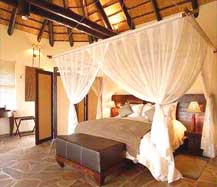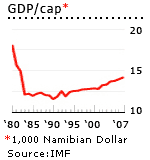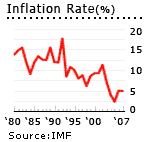Windhoek housing market still up
 House prices in the capital Windhoek are still rising. However, prices are showing signs of softening due to the weaker performance of properties at the top end of the market.
House prices in the capital Windhoek are still rising. However, prices are showing signs of softening due to the weaker performance of properties at the top end of the market.
The First National Bank (FNB) of Namibia housing index for Windhoek fell from 115.68 registered in the 4th quarter of 2005 to 113.25 in the 1st quarter of 2006. However, the index still registered a 13.25% y-o-y growth from the first quarter of 2005 to 2006.

Residential property prices in the capital, Windhoek, have increased by 90% since 2001. House prices in Namibia in general rose by more than 100% from 1993 to 2005, while the increase from 2001 to 2005 was about 50%.
Areas that registered the highest y-o-y growth for the first quarter of 2006 among Windhoek suburbs were Rocky crest with 28.33%, Pioneer Park 26.85%, Otjomuise 26.3%, Dorado Park 23.7% and Windhoek West with 19.3% price increase.
Fundamentals
The residential real estate market has experienced strong and constant growth since 2001 due to good macroeconomic fundamentals such as low inflation and interest rates.
The economy grew by an annual average of 3.8% from 1994 to 2005. Real wages rose about 5% in 2005. The inflation rate was at 5.8% in 2005, down from 11.3% in 2002. The prime lending rate was 11.75%, lower than the 17% registered in 2002 and 24% in 1998.
 The slowdown in 2006 is mainly attributed to weaker activity at the top end of the market. The FNB notes that prices are not falling, it is just that more lower-priced units were included in the index for the given period. They report further that since wages are growing in line with inflation at around 5%, while house prices are rising at 13%, demand for high priced houses has been dampened.
The slowdown in 2006 is mainly attributed to weaker activity at the top end of the market. The FNB notes that prices are not falling, it is just that more lower-priced units were included in the index for the given period. They report further that since wages are growing in line with inflation at around 5%, while house prices are rising at 13%, demand for high priced houses has been dampened.
The performance of mid-priced housing is still strong, though. Private sector demand for home loans registered an annual increase of NAD1.6 billion, about 20%, for the year ending February 2006.